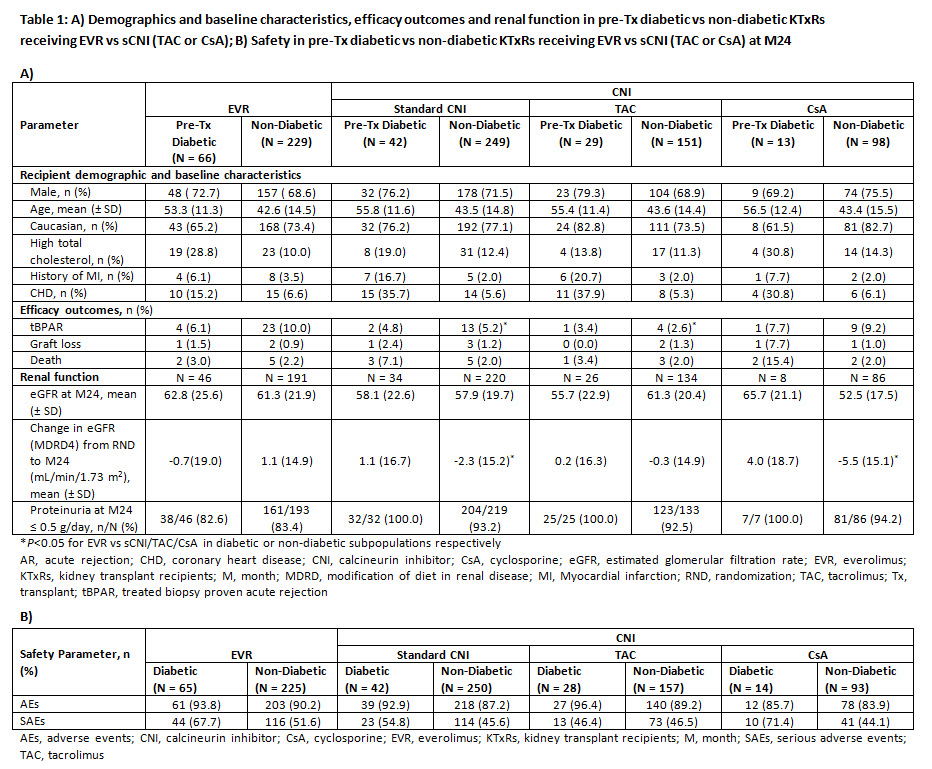Effect of Everolimus-Based Regimen on Graft Outcomes in Kidney Transplant Recipients with Diabetes at Baseline: Post-Hoc Analysis from the ELEVATE Study.
1ELEVATE Study Group, Leiden, Netherlands
2Novartis Pharma AG, Basel, Switzerland
Meeting: 2017 American Transplant Congress
Abstract number: D82
Keywords: Efficacy, Immunosuppression, Kidney transplantation, Renal function
Session Information
Session Name: Poster Session D: Kidney Immunosuppression: Novel Regimens and Drug Minimization
Session Type: Poster Session
Date: Tuesday, May 2, 2017
Session Time: 6:00pm-7:00pm
 Presentation Time: 6:00pm-7:00pm
Presentation Time: 6:00pm-7:00pm
Location: Hall D1
Purpose: Presence of diabetes may have adverse impact on graft outcome in kidney transplant recipients (KTxRs). This post-hoc analysis from the ELEVATE study compared the graft outcomes in pre-transplant (Tx) diabetic and non-diabetic KTxR subpopulations randomized to everolimus (EVR) or standard calcineurin inhibitor (sCNI) regimen.
Methods: ELEVATE (NCT01114529), a 24 Month (M), multicenter, open-label trial randomized de novo KTxRs 10-14 weeks post-Tx to convert from sCNI to EVR (n = 360; trough level [C0]: 6-10 ng/mL) or to continue sCNI (n = 357, C0: tacrolimus 5-10 ng/mL [n = 231], cyclosporine 100-250 ng/mL [n = 126]); all received enteric-coated mycophenolate sodium and steroids. The effect of both regimens on efficacy (treated biopsy proven acute rejection [tBPAR]), renal function (estimated glomerular filtration rate [eGFR], proteinuria) and safety at M24 was analyzed in pre-Tx diabetic and non-diabetic KTxR subpopulations.
Results: At baseline, mean age, and incidences of high total cholesterol, history of myocardial infarction and coronary heart disease were higher in pre-Tx diabetic compared to non-diabetic subpopulation, irrespective of treatment arm. At M24, incidence of tBPAR was higher with EVR vs sCNI irrespective of diabetic status. Mean eGFR and mean change in eGFR from randomization were comparable with EVR vs sCNI arm in pre-Tx diabetic KTxRs while there was significant improvement with EVR vs sCNI arm in non-diabetic KTxRs. Majority of patients in both arms had mild proteinuria irrespective of diabetic status (Table A). The incidence of adverse events was higher with pre-Tx diabetic vs non-diabetic subpopulations within each arm (Table B).
Conclusion: Graft outcomes were comparable between treatments irrespective of the diabetic status prior to transplantation.
CITATION INFORMATION: de Fijter J, Holdaas H, Sanders J, Sundar S, Bemelman F, Lopez P, Bader G, Cruzado J, van der Giet M. Effect of Everolimus-Based Regimen on Graft Outcomes in Kidney Transplant Recipients with Diabetes at Baseline: Post-Hoc Analysis from the ELEVATE Study. Am J Transplant. 2017;17 (suppl 3).
To cite this abstract in AMA style:
Fijter Jde, Holdaas H, Sanders J, Sundar S, Bemelman F, Lopez P, Bader G, Cruzado J, Giet Mvander. Effect of Everolimus-Based Regimen on Graft Outcomes in Kidney Transplant Recipients with Diabetes at Baseline: Post-Hoc Analysis from the ELEVATE Study. [abstract]. Am J Transplant. 2017; 17 (suppl 3). https://atcmeetingabstracts.com/abstract/effect-of-everolimus-based-regimen-on-graft-outcomes-in-kidney-transplant-recipients-with-diabetes-at-baseline-post-hoc-analysis-from-the-elevate-study/. Accessed December 18, 2025.« Back to 2017 American Transplant Congress
